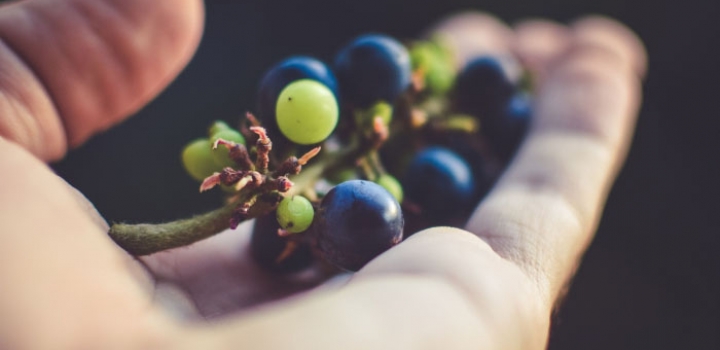
By Megan Sahli | Originally published on 01 November 2016 by Urban Walkabout
Lately, natural (or non-interventionist) wines have been the buzzword of many new wine bars and restaurants across Australia. But isn’t wine a natural product anyway? I mean, it comes from grapes right? So what’s all the fuss about?
How to make a natural wine
Here’s (roughly) how traditional winemaking words: after grapes are picked and then crushed, the ferment will start either with inoculated (added) yeast or naturally occurring yeast. The yeast cells will much on the sugar cells of the grapes, and alcohol is produced. (So the higher the sugar content; the more alcohol produced.)
Typically, natural wine is cloudy (unfined and unfiltered); tastes of fermented grape juice (literally) and will often have an orange hue. Mostly importantly, natural wines won’t contain sulphur (much), a preservative usually added at the start of the fermentation process. In this sense, a natural wine is a living product, which is why they have a diminished shelf life, due to the lack of preservatives and reliable yeast additions.
It’s all in the soil
For centuries, the Old World of wine (think Europe and parts of the Mediterranean) made products that spoke to their place of origin. This connection to terroir is really what wine is all about – where wines are described by place and not by varietal. For example, a pinot noir in France is not called pinot noir: it is called Burgundy. The New World cannot pretend to place as much emphasis on terroir (although we’re trying to prove this assumption wrong).
Colonies importing winemaking technologies from the Old World like Australia, New Zealand, the United States and Argentina, have had to figure out the best areas to grow grapes through trial and error, placing their emphasis on modern industrial practices and much experimentation. Because of this, New World wine is good, it can be exceptional, and certainly is inventive.
This brings us back to natural wine and the difficulties the industry faces in discerning exactly what this classification entails. The book Wine and Culture: Vineyard to Glass edited by Rachel E. Black and Robert C. Ulin notes how: “For wine, the term natural is negotiated between producers, importers/distributors, wine writers and bloggers, and consumers.”
Wine conversations happen in “wine bars, shops, and cellars” as well as in the blogosphere, where everyday people can write what they like. This creates perpetuating contradictions, for there is still no universally agree-upon definition of natural wine.
Natural wine in practice
Natural wine importer Giorgio de Maria has been importing Italian wines for seven years. He says he has always kept an eye out for “wines that have the least possible additions and the best chemical-free fruit.”
Giorgio says natural wine is all about the land or the aforementioned terroir of the vineyard.
“[Viticulturalists] must not take away from the soil, but give back to the land [to look after] the microbiology in the vineyard.”
Everything in the winemaking process is important: the bacteria, the natural yeasts, and the natural sulphurs, which all occur in well-managed vineyards.
The grower-vintners successfully producing top-quality natural wine are the ones committed to these organic and sometimes biodynamic farming practices. These are the producers sticking to the living heart of the product.
Spirit People’s distilled spirits expert Angus Burton believes that “if you farm biodynamically, with loads of animals, with plants like lavender around and no chemicals, you get healthy strong grapes”.
“[W]hen healthy grapes are vinified well, trendy practices like skin contact are used in the winemaking process to actually help stabilise the wine. By adding colloids, tannins and other acids, the structure of the wine will remain intact.”
Just because it’s cloudy doesn’t mean it’s good
While a natural wine may be produced with quality and integrity, what can go wrong for these producers is that the everyday consumer will often buy on aesthetic. Sure, a cloudy fruity-juicy wine might look natural, but this may not be the case. Some producers cash in on the aesthetic, aligning themselves with ‘natural’ on-trend products and getting away with making less than satisfactory wines that still use interventionist practices.
Jauma Wines, on the other hand, hailing from the McLaren Vale region of South Australia, are hand harvested without the addition of sulphur, yeasts, acids, enzymes, polymers, tannins or filtration.
“I believe in the integrity and honesty of my wines,” says owner and manager James Erskine.
Another winery to focus on the quality and integrity of their products is Cullen Wines from the Margaret River in Western Australia.
Vanya from Cullen Estate believes that [b]iodynamics is a way of creating life and aliveness in the wine”.
“By using homeopathic plant-based remedies and only natural preparations applied at advantageous times, we great uniqueness and quality… in a tangible sense this is about using products from nature, which enliven the land and wine.”
Distinguishing natural from nonsense
Wine makers, just like agriculturalists, should be looking forward. Organic and biodynamic farming methods are increasingly the only way to ensure sustainable farming.
Neil Prentice from Moondarra and Holly’s Garden wines, has used biodynamic practices since 1991. Not, he says, “for any altruistic reason, but to grow better grapes”.
“I believe the wines we produce reflect their provenance.”
Even so, vinicultural practices are so dependent on the macro and microclimates of the vineyard that making great natural wines is very difficult and sometimes near impossible. What non-interventionist producers will need to consider is how they will differentiate their genuine natural wines from products of less integrity.
And while the increasing list of natural wines in Australia and overseas is exciting, these living products will always be in shorter supply.
Natural wine is a product for artisanal producers, so the next time you see a big-brand wine marketing itself as natural, perhaps think twice and consider just how unlikely that product is to be truly living.




